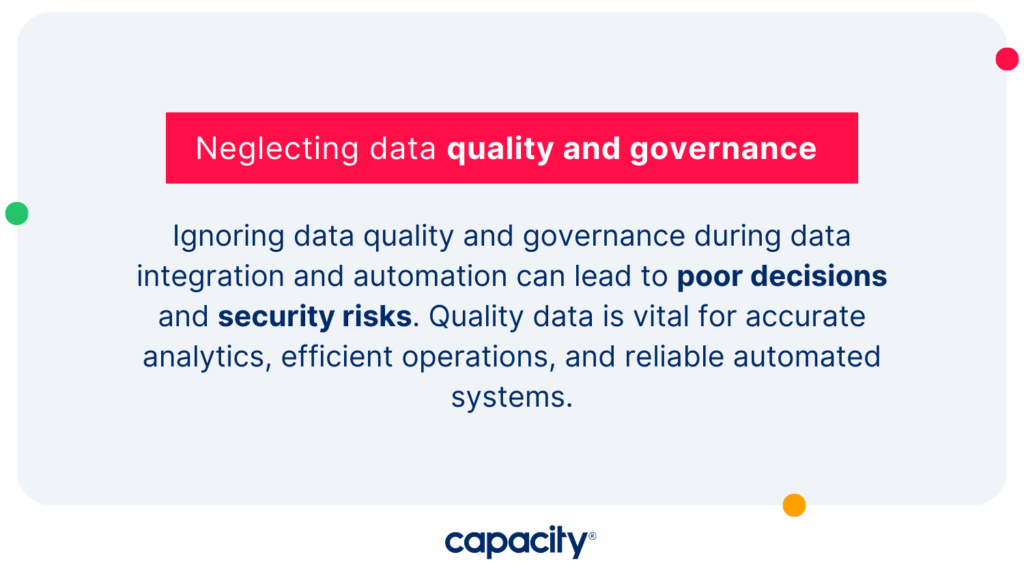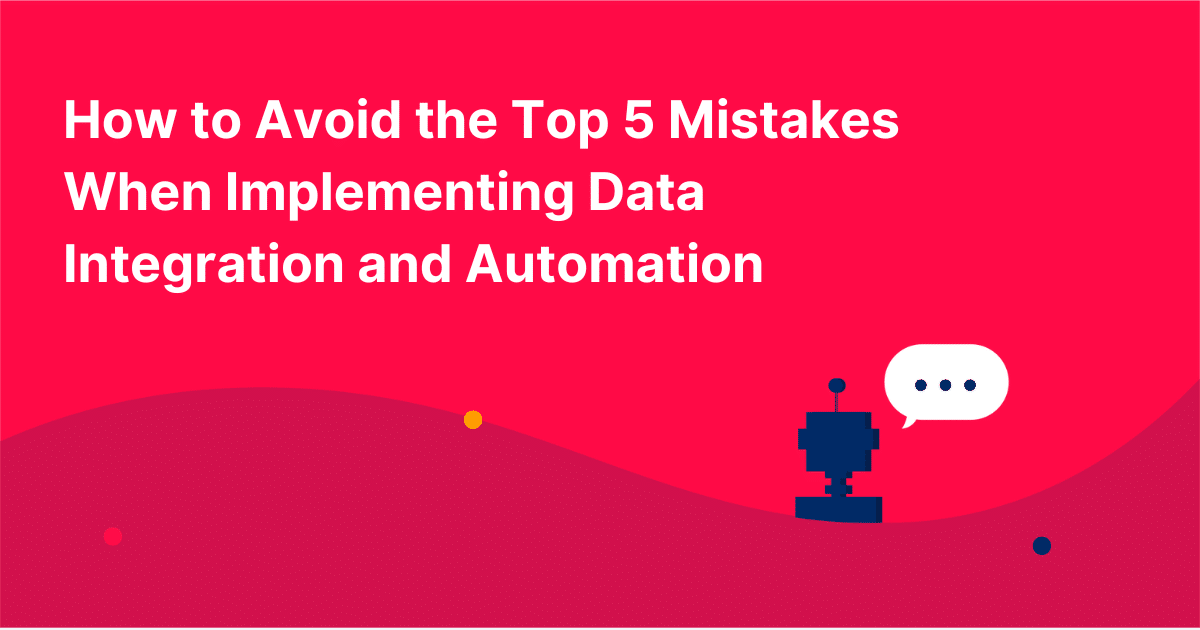Data integration and automation are vital in modern businesses. Data integration merges information from different sources, offering a comprehensive view for informed decision-making. Automation uses technology to streamline processes, enhancing efficiency and accuracy. Both enable businesses to understand market trends, boost productivity, cut costs, and improve customer satisfaction.
However, implementation can be challenging. Data integration involves handling diverse data types, necessitating effort to ensure compatibility. Privacy and security concerns are paramount, as data must be securely stored and handled.

Automate Your Work
Capacity’s enterprise AI chatbot can help:
- Answer FAQs anytime, anywhere
- Find relevant documents within seconds
- Give surveys and collect feedback
Automation, while cost-saving in the long run, requires an initial investment that may be substantial. It can disrupt existing processes and may encounter employee resistance. Both automation and data integration necessitates technical expertise, potentially increasing costs for training or hiring.
Despite these challenges, the benefits of data integration and automation, such as improved decision-making and efficiency, make them essential investments for businesses. Here, we will explain the five mistakes to avoid when implementing data integration and automation so your business can effectively use its data, optimize processes, drive innovation, and stay competitive.
5 Mistakes to avoid when you’re implementing data integration and automation

Mistake #1: Insufficient planning and strategy
Implementing data integration and automation without sufficient planning and strategy is a common mistake that can result in inefficiencies, delays, and cost overruns. A well-defined strategy is crucial because it serves as a blueprint for managing the transition from existing processes to new automated ones and integrating various data sources. A market study from IDG and TeamDynamix found 89% of companies struggle with data and system integration.
Implementing data integration and automation without thorough planning can lead to inefficiencies and extra costs. A robust strategy is a guideline for transitioning to automated processes and amalgamating data sources.
Setting clear objectives is critical to ensure alignment with broader business goals. Assessing existing systems highlights potential integration points and areas where automation can add the most value. Also, potential challenges can be identified and mitigated early. Developing a roadmap lays out steps, timelines, resources, and assigns responsibilities, which minimizes confusion during implementation. It also helps anticipate future growth, making the new system scalable.
Mistake #2: Neglecting data quality and governance

Ignoring data quality and governance during data integration and automation can lead to poor decisions and security risks. Quality data is vital for accurate analytics, efficient operations, and reliable automated systems.
Data governance policies and procedures help manage and protect data, ensuring it’s used and accessed appropriately. They bolster data accuracy, consistency, and security, fundamental for valuable insights and safe automation.
Continuous monitoring of data quality and establishing remediation processes are necessary for maintaining high-quality data over time. These practices help identify and rectify issues promptly, safeguarding the efficacy of the automated systems and the accuracy of analytics.
In essence, strong data quality and governance are the bedrock of successful data integration and automation, ensuring reliable, safe, and insightful operations.
Mistake #3: Overlooking change management
Overlooking change management in data integration and automation implementations can lead to resistance, inefficiency, and project failure. Such transformations significantly affect your company, thus handling change effectively is crucial.
Involving stakeholders and end-users throughout the process ensures their needs are met and their feedback is considered, which boosts acceptance and a smooth transition. Training is vital, as it equips users with the skills to effectively use the new system, promoting productivity.
Providing ongoing support helps users adapt to changes and resolve issues, minimizing downtime and frustration. Clearly communicating the benefits of the transformation and addressing concerns can gain buy-in from all stakeholders, fostering a supportive environment for change. In short, effective change management is key to successful data integration and automation, facilitating smooth transitions, high adoption rates, and optimal use of new systems.
Mistake #4: Failing to consider scalability and flexibility
Neglecting scalability and flexibility during data integration and automation implementations can lead to future limitations. As businesses evolve, their data requirements change, necessitating systems that can adapt and grow.

Understanding long-term needs is vital in choosing technologies and platforms. Solutions must be able to handle increased data volumes, additional data sources, and different formats without significant overhauls. A joint survey from Mulesoft and Deloitte found that companies now use an average of 976 applications, only 28% of which are integrated. Scalable technologies provide the capacity to accommodate business growth and increased data processing needs without compromising performance. Flexible platforms support different data types and integration patterns, enabling your business to adapt to new requirements efficiently. A modular and extensible architecture is beneficial for accommodating new components or functionalities as needs change. It allows for easier updates and enhancements without disrupting existing operations.
Mistake #5: Lack of continuous monitoring and optimization
Ignoring continuous monitoring and optimization in data integration and automation efforts is a misstep that can lead to underperformance and inefficiencies. An ‘implement and forget’ mindset can leave potential issues undiscovered and unaddressed.
Emphasizing ongoing monitoring and optimization is crucial. Constant surveillance helps identify bottlenecks, errors, or inefficiencies in real time, enabling immediate corrective action. This proactive approach enhances the system’s reliability and efficiency. It’s also important to note that implementing robust performance tracking and analytics is vital. It provides actionable insights into the system’s performance, data quality, and process efficiency, guiding strategic decisions and improvements.
Regular assessments of integration and automation processes are essential to ensure they continue to meet evolving business requirements. Continuous improvement initiatives, guided by insights from analytics, can optimize these processes, enhance efficiency, and improve data accuracy.
All in all, successfully implementing data integration and automation is a strategic move that can greatly enhance a business’s efficiency, decision-making ability, and overall competitiveness. However, this journey isn’t without its challenges. Failing to properly plan, neglecting data quality, overlooking change management, failing to consider scalability and lack of continuous monitoring and optimization can severely hamper your efforts and limit the benefits of these transformative technologies.
Avoiding these common pitfalls requires strategic foresight, strong governance, comprehensive planning, and a commitment to continuous improvement. By understanding and navigating these complexities, businesses can successfully harness the power of data integration and automation, reaping benefits like improved efficiency, enhanced data-driven decision-making, and a more agile and resilient organization.

Automate Your Work
Capacity’s enterprise AI chatbot can help:
- Answer FAQs anytime, anywhere
- Find relevant documents within seconds
- Give surveys and collect feedback





